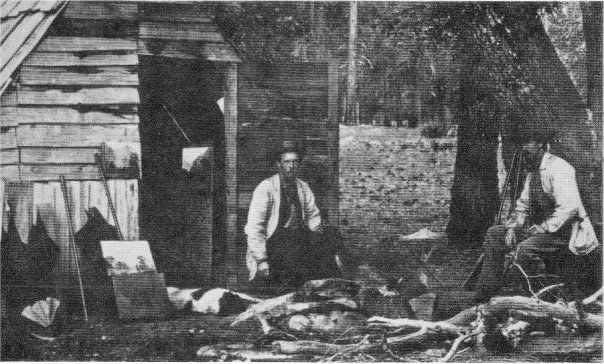
| Online Library: | Title | Author | California | Geology | History | Indians | Muir | Mountaineering | Nature | Management |
Yosemite > Library > Wawona’s Yesterdays > Thomas Hill >
Next: Famous Visitors • Contents • Previous: Steve Cunningham
Thomas Hill was not only a Western artist of world renown, he was Wawona’s own! His daughter, Estella, married John Washburn in 1885 and Hill had a studio, now the recreation building, at the hotel from the year of their marriage until his death. A gushing fountain in front of a long porch made Hill’s Studio a popular place for hotel guests to lounge as well as browse and buy.
In addition to paintings, Hill sold such curios as squirrel pelts, dried flowers and rattlesnake skins. His vine-covered studio was crowded with a splendid collection of Indian war implements, bear skins and wasps’ nests. 58 He liked to dine on quail and smoked cigars incessantly. He had studied under Paul Mayerheim in Paris, mainly used browns and yellows in his paintings and did some of his best work when his studio was crowded with friends. 59 He was a hard and prolific worker and thanks, partly, to the fact that hotel guests were the elite of the tourist trade, many of his Yosemite landscapes were carried to England and Europe.
According to Hutchings, Hill was “. . . a very genial gentleman, who has been everywhere, almost — if not a little beyond — seen about as much as most men, and can tell what he has seen pleasantly, including haps and mishaps . . .” 50
He was born in England September 11, 1829, came to Massachusetts in 1841 and moved to California for his health in 1861; and, later, established his summer studio at Wawona and his winter quarters in Raymond.
His wife, after years of invalidism, died in the early 1900’s. They had four children and he was noted as a family man. He sought commercial success, gained it, but invested his money poorly and lost several small fortunes. 15 From 1900 on, Hill was constant ill health, and he died in Raymond on June 30, 1908. 60
Hill’s most famous painting “Driving the Last Spike,” had nothing to do with Yosemite, but pictures the driving of the last spike to unite the transcontinental railway at Promontory, Utah, in 1869. Not even painters were safe from politics, Hill found to his dismay long before he finished the huge painting.
Leland Stanford, of California’s famous Big Four, had commissioned it for $50,000, Hill said, but he kept having Hill rearrange the recognizable personages in it. Of some 400 people pictured witnessing the union of the two railroads, seventy were the VIP’s of the 1860’s and Stanford decreed who should and shouldn’t be displayed prominently.
When a powerful opponent objected to Stanford’s own showy place in the painting, the rail magnate abruptly refused to pay for it. Hill was sick at heart, out of four years’ and pocket on large expenditures for the canvas. 63 He fled east, but his health suffered anew in the rigorous climate and he was forced to return to the land of sunshine.
Because of its historical significance, the disputed painting was purchased for $10,000 after Hill’s death by the E. B. Crocker Gallery of Sacramento and hangs now in the California capitol building.
Deservedly, his fine landscapes won 36 medals and prizes as well as world-wide sale and written praise. 62 Some of them can be viewed at the Yosemite Museum, the Wawona Hotel and the restored Jorgenson’s Studio in the Pioneer History Center at Wawona.
Artists Virgil Williams and Thomas Hill

|
Next: Famous Visitors • Contents • Previous: Steve Cunningham
| Online Library: | Title | Author | California | Geology | History | Indians | Muir | Mountaineering | Nature | Management |
http://www.yosemite.ca.us/library/wawonas_yesterdays/thomas_hill.html